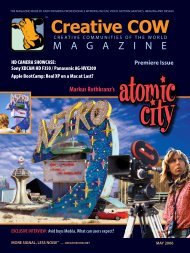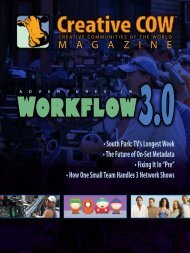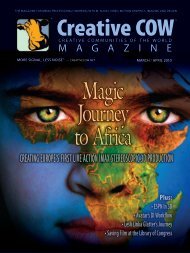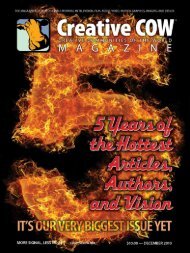You also want an ePaper? Increase the reach of your titles
YUMPU automatically turns print PDFs into web optimized ePapers that Google loves.
“IT HITS THE FAN”<br />
An inside look at TV’s longest week: the teamwork and technology<br />
behind the Emmy Award-winning worldwide hit, “<strong>South</strong> <strong>Park</strong>”<br />
Each episode of “<strong>South</strong> <strong>Park</strong>” comes to life in six<br />
days, start to finish — a crazy pace for an animated<br />
series. Even crazier: each episode arrives at Comedy<br />
Central in New York via uplink somewhere between<br />
6:30 and 8:30 PM on Wednesday, to be shown that<br />
night at 10 PM.<br />
Cutting it close? Even a production as relatively<br />
simple as a late-night talk show, where delivery might<br />
entail no more than walking across the same building<br />
it’s taped in, leaves more like five hours to air than<br />
three.<br />
And because work proceeds on each episode until<br />
the very last minute, an awful lot of things have to<br />
go right, in very short order, with virtually no margin<br />
for error.<br />
It’s not just that the script has to be completed<br />
in time for voice recording, creating and rendering<br />
animation (including lip sync), color correction, visual<br />
effects, scoring and audio post. It’s that the script<br />
keeps changing to respond to the world’s most current<br />
events, as well as the perfectionism of the show’s creators.<br />
Which means that everything downstream from<br />
Tim Wilson “Timmeh!”<br />
Boston, Massachusetts USA<br />
the script keeps changing too.<br />
Their perfectionism is paying off. Now in its twelfth<br />
season, “<strong>South</strong> <strong>Park</strong>” has been nominated for 7 Emmy<br />
Awards for Best Animated Program, winning in 2005<br />
and 2006 — and just as this issue was wrapping, the<br />
three-parter “Imaginationland” was awarded the 2007<br />
Emmy for “Outstanding Animated Program<br />
(For Programming<br />
One Hour Or More).”<br />
<strong>South</strong> <strong>Park</strong> has<br />
also won a GLAAD<br />
Award, an NAACP Image<br />
Award, a CableACE<br />
Award, and the prestigious<br />
Peabody Award,<br />
among others.<br />
Not bad for a cartoon<br />
show about four<br />
foul-mouthed boys<br />
intended to look like it<br />
was animated from construction paper<br />
cut-outs.<br />
“I’d have finished this article a whole lot faster if I hadn’t kept stopping to watch<br />
more episodes of ‘<strong>South</strong> <strong>Park</strong>,’” says Tim. Exhibit A: the article title and each of<br />
the section headings is taken from an episode title. Pathetic.<br />
EMMY is a registered trademark of the National Academy of Television Arts & Sciences. All rights are reserved.<br />
“PROFESSOR CHAOS”<br />
Workflow at <strong>South</strong> <strong>Park</strong> Studios has evolved with<br />
the sole purpose of giving creators and executive<br />
producers Matt Stone and Trey <strong>Park</strong>er the room<br />
to write, direct, add additional music to the work<br />
of <strong>South</strong> <strong>Park</strong>’s composers, and if called for, to<br />
write songs, in such little time.<br />
Before attending the University of Colorado<br />
where he met Matt, Trey studied at Boston’s<br />
Berklee College of Music. His song “Blame Canada,”<br />
co-written with Marc Shaiman for the movie<br />
“<strong>South</strong> <strong>Park</strong>: Bigger, Longer, Uncut” was nominated<br />
for an Academy Award for Best Song.<br />
The two also provide voices for most of the<br />
show’s male characters.<br />
Supervising Producer Frank Agnone is the<br />
keeper of the workflow for the sixty people who put<br />
the show together. From the time that pages for the<br />
next episode arrive early in the morning after the previous<br />
one airs, he makes sure that a lot of things happen<br />
simultaneously.<br />
The basics are<br />
traditional enough:<br />
those early pages are<br />
recorded, the dialog<br />
is cut up and passed<br />
to storyboard artists.<br />
Editors start<br />
building animatics<br />
by cutting together<br />
the storyboards and<br />
dialog to start shaping<br />
the scene.<br />
Of course, even after the first pages arrive and<br />
scene construction begins, nobody necessarily knows<br />
where in the show it’s going to end up. The script<br />
evolves as the week progresses: the final script is<br />
generally in place around 2 AM Wednesday, about 12<br />
hours before the show is uploaded for air.<br />
Until then, the work carries on, scene by scene. As<br />
editor David List notes, “It doesn’t matter so much to<br />
us whether a scene is at the beginning or end, as far<br />
as editorial is concerned. The challenge is more<br />
for Matt and Trey as they build the story structure.<br />
For us, it’s basically cutting. We know from<br />
the beginning that there will be changes as we<br />
go, but we’ve been doing this for so long that we<br />
know how to keep moving.”<br />
At the same time that Frank is working with<br />
Trey to refine individual layouts, 3D modeling<br />
begins. Those shots move very rapidly through<br />
lip sync and into the hands of the animators.<br />
“So it’s an ever changing formula,” says<br />
Frank, “but ultimately it’s my responsibility to<br />
make sure that the team of sixty people is staying<br />
on schedule and we are hitting our deadlines<br />
for Trey, hitting our video deadlines so that color<br />
correction can happen on time, and then our audio<br />
deadlines so that we’re making broadcasts<br />
on time.”<br />
“TWO DAYS BEFORE THE DAY AFTER TOMORROW”<br />
Things get especially hairy on the last day: a 30-hour<br />
stretch that begins early Tuesday morning on the way<br />
to completion by Wednesday afternoon.<br />
Picture lock comes in for a landing at 9 AM Wednesday<br />
morning, when the video is recorded to tape and<br />
sent out for final color correction. At the same time,<br />
the final clean-up and re-conform from last-minute<br />
edits gets sent through audio post one last time.<br />
“Then the scramble is on for those guys to make<br />
sure all of the proper dialog and ADR work is in place,”<br />
says Frank. “Sound design for shots that are coming in<br />
until that 9 AM hour on Wednesday morning are also<br />
attended to, and then a mix begins.”<br />
The mix comes together just as the color graded<br />
picture comes back at 1 PM Pacific, when Frank pulls<br />
the plug on any additional work. “If I’m lucky, I’m out<br />
the door by 2 PM, sometimes 2:30, to our uplink facility<br />
to start fibering the episode to New York. On average<br />
the show arrives on the east coast between 6:30 and 7<br />
PM [Eastern], and it’s on the air at 10 PM.<br />
“We had a couple of shows in this last run where<br />
I was getting the show there as close as 8:30 for a 10<br />
o’clock broadcast.”<br />
It’s difficult enough to keep track of all this as it’s<br />
being described that it raises the obvious question:<br />
8 September / October 2008 — <strong>Creative</strong> <strong>COW</strong> <strong>Magazine</strong><br />
<strong>Creative</strong> <strong>COW</strong> <strong>Magazine</strong> — September / October 2008 9










